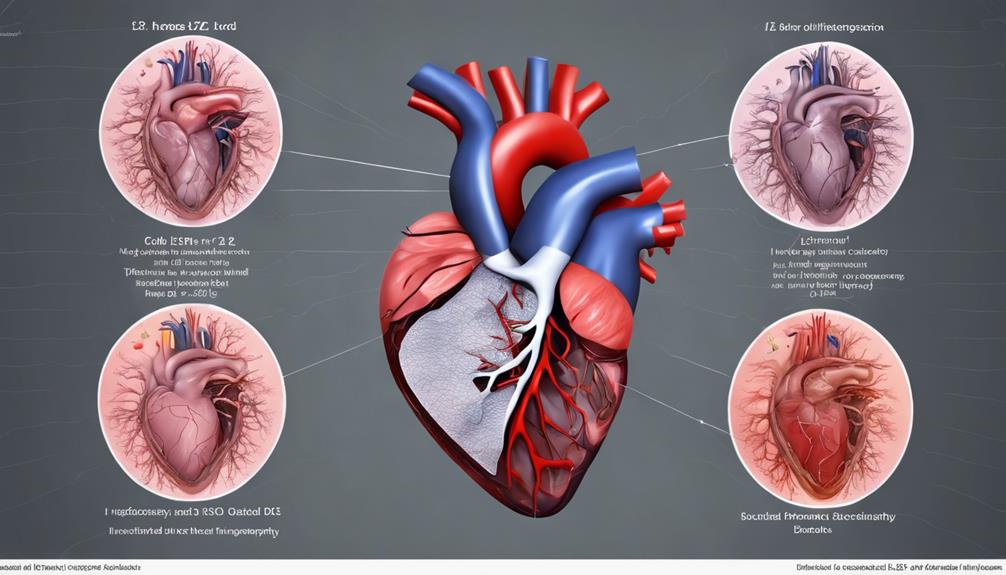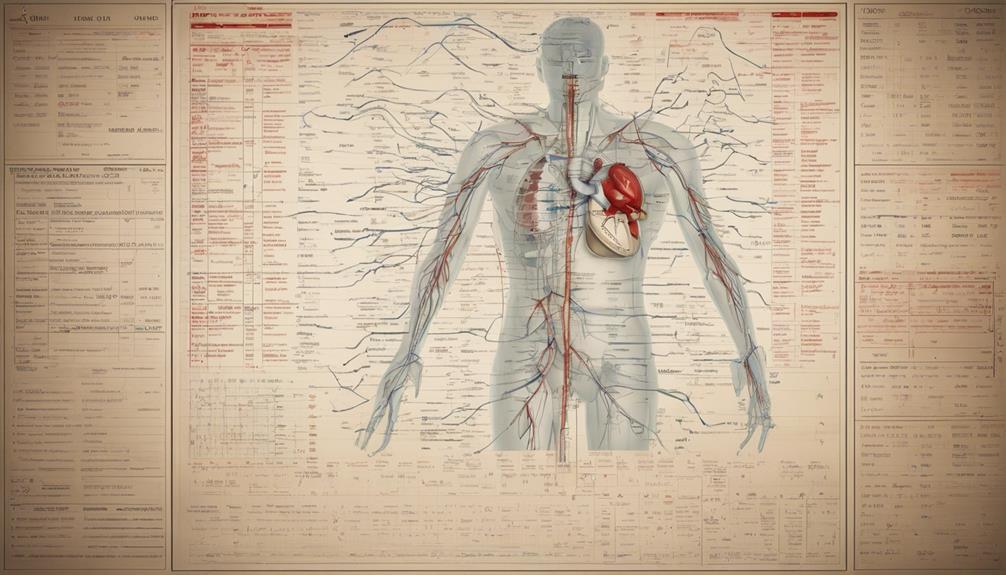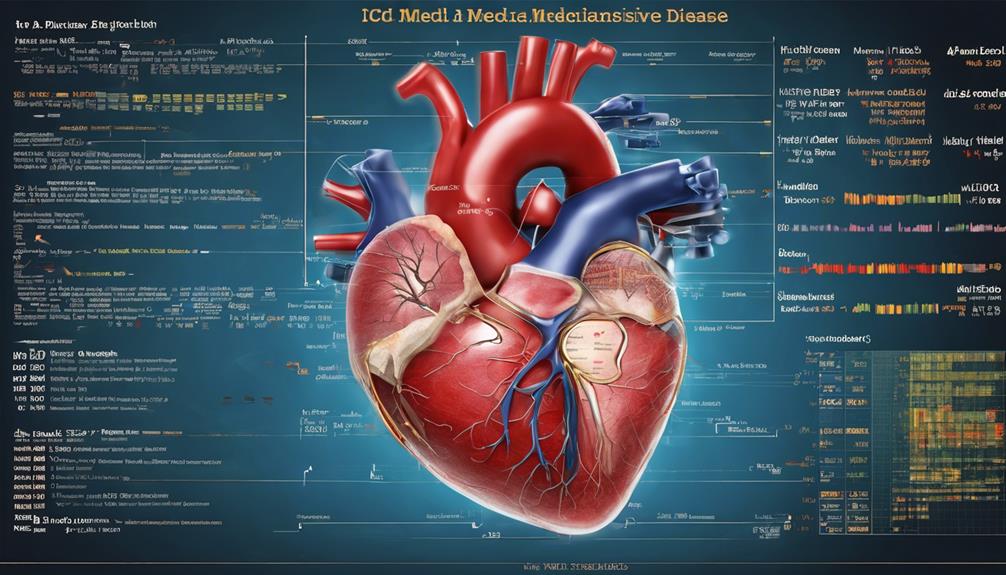When dealing with Ischemic Heart Disease, it is essential to grasp the significance of the ICD-10 code for precise documentation and billing purposes. The intricate nature of this illness requires accurate coding to guarantee appropriate treatment and coordination of care. Discover why having a solid understanding of this code is essential for effectively managing this health condition.
Exploring the nuances of ICD-10 Code I25 can shed light on the specifics of Ischemic Heart Disease classification and help healthcare professionals navigate the intricacies of diagnosis and management effectively.
Stay tuned to unravel the significance of proper coding in the realm of cardiovascular health.
Key Takeaways
- ICD-10 codes aid accurate diagnosis and treatment.
- Proper coding essential for billing and insurance claims.
- Classification enables effective communication and disease tracking.
- Guidelines ensure standardized reporting for ischemic heart disease.
Overview of Ischemic Heart Disease
Ischemic Heart Disease involves a condition characterized by reduced blood flow to the heart muscle as a result of atherosclerosis. This reduction in blood flow deprives the heart of the oxygen and nutrients it needs to function optimally, leading to various complications such as angina, heart attacks, and heart failure. Risk factors such as smoking, high blood pressure, and diabetes contribute to the development and progression of ischemic heart disease.
Diagnosis of ischemic heart disease typically involves a thorough medical history review, physical examinations, electrocardiograms (ECG), and angiography to assess the extent of blockages in the coronary arteries. Treatment options vary depending on the severity of the disease and may include medications to manage symptoms and prevent further complications, lifestyle modifications like diet and exercise, as well as surgical interventions such as angioplasty or bypass surgery to restore blood flow to the heart muscle.
Early detection and management of ischemic heart disease are crucial in preventing adverse outcomes and improving the quality of life for affected individuals.
Importance of ICD-10 Coding

Utilizing accurate ICD-10 coding is paramount in the healthcare industry for precisely documenting and tracking diagnoses, especially for conditions like Ischemic Heart Disease.
- Standardized Communication: Proper ICD-10 coding ensures consistent and clear communication among healthcare providers, insurance companies, and researchers, facilitating better coordination of care.
- Coding Accuracy: The ICD-10 code range I20-I25 offers specific codes for different types and stages of ischemic heart diseases, enabling precise coding for accurate diagnosis and treatment.
- Financial Operations: Accurate ICD-10 coding is essential for billing purposes and insurance claims related to ischemic heart disease, ensuring proper reimbursement and financial stability for healthcare organizations.
- Treatment Planning: Understanding and using the correct ICD-10 code for ischemic heart disease is vital for developing appropriate treatment plans and monitoring patients effectively, leading to improved outcomes and quality of care.
ICD-10 Code I25 for Ischemic Heart Disease
The ICD-10 code I25 classifies various types and stages of ischemic heart diseases, providing a detailed framework for accurate diagnosis and treatment. This specific code range is crucial in distinguishing between different conditions such as angina, myocardial infarction, and other related ischemic heart diseases.
By utilizing the ICD-10 code I25, healthcare providers can precisely categorize patient encounters, enabling effective communication and documentation of diagnoses related to ischemic heart diseases. Assigning the correct ICD-10 code I25 is essential for medical billing accuracy, tracking disease prevalence, and ensuring proper documentation of cases.
These codes play a significant role in research, quality improvement initiatives, and healthcare planning by aiding in the classification and coding of ischemic heart disease cases. Understanding the ICD-10 code I25 system is fundamental for healthcare professionals to accurately diagnose, treat, and manage patients with ischemic heart diseases, contributing to improved patient care outcomes and overall healthcare quality.
Subcategories of I25 Code

Within the I25 code range of the ICD-10, subcategories delineate distinct forms and stages of chronic ischemic heart disease. Understanding these subcategories is crucial for accurate diagnosis and appropriate management.
Here are some key subcategories under the I25 code:
- Stable Angina: Characterized by predictable chest pain or discomfort that occurs with physical exertion or stress.
- Unstable Angina: Presents as unexpected chest pain or discomfort that may occur even at rest and is a sign of an impending heart attack.
- Chronic Total Occlusion: Refers to a complete blockage in one or more of the coronary arteries, leading to reduced blood flow to the heart muscle.
- Coronary Artery Disease and Ischemic Cardiomyopathy: Encompass broader aspects of ischemic heart disease, involving the arteries supplying blood to the heart muscle and the resultant heart muscle dysfunction due to ischemia.
These subcategories help healthcare providers differentiate between various manifestations and severity levels of ischemic heart disease, guiding them in formulating tailored treatment plans and monitoring patient progress effectively.
Coding Guidelines and Tips
To ensure accurate documentation and billing for services related to ischemic heart disease, healthcare providers must adhere to specific ICD-10-CM coding guidelines and utilize the appropriate codes within the I20-I25 range. Proper coding is crucial for capturing the nuances of different types and stages of ischemic heart diseases, enabling precise diagnosis, treatment planning, and monitoring of patient progress.
These coding guidelines establish a standardized framework for reporting ischemic heart disease cases consistently across medical records, ensuring data accuracy and integrity. Healthcare providers need to be well-versed in the specific ICD-10-CM codes within the I20-I25 range to effectively document and bill for services associated with ischemic heart disease.
Frequently Asked Questions
What Is the ICD Code for Ischemic Disease?
We understand the importance of accurately identifying medical conditions. Assigning the correct ICD code for ischemic disease is crucial for proper diagnosis and treatment.
The ICD-10-CM code range I20-I25 covers various types and stages of ischemic heart diseases, aiding healthcare professionals in accurate documentation. Using the appropriate code ensures consistency in medical records and facilitates communication among healthcare providers.
It's essential to assign the correct code for effective treatment, billing, and tracking of the condition.
What Is the Ischemic Heart Disease?
Ischemic heart disease is a condition where reduced blood flow to the heart muscle affects oxygen supply, leading to symptoms like angina and heart attacks.
It's vital to address risk factors such as smoking, high blood pressure, and diabetes to prevent its progression.
Diagnosis and treatment involve various medical interventions to manage the condition effectively and improve cardiac function.
Lifestyle modifications, medications, and surgical procedures play crucial roles in combating ischemic heart disease.
What Is the ICD 9 Code for Ischemic Heart Disease?
We'll address the ICD-9 code for ischemic heart disease, crucial for accurate medical coding.
The code 414.00 categorizes chronic ischemic heart disease cases. By using this code, healthcare providers can document and classify instances of reduced blood flow to the heart due to conditions like atherosclerosis.
This system replaced ICD-9 with ICD-10, offering more detailed disease codes. Proper use ensures accurate tracking and billing, benefiting both providers and insurers.
What Is the ICD-10 Code for I25.13?
We accurately classify conditions with ICD-10 codes. I25.13 specifically denotes atherosclerotic heart disease with documented spasm. This code is crucial for precise identification in medical billing and record-keeping.
It falls within the I25 category range, covering various ischemic heart diseases. Proper use of I25.13 ensures accurate coding of cases with associated spasm. This code aids in healthcare settings for clear classification of ischemic heart disease with documented spasm.
Conclusion
In conclusion, understanding the ICD-10 coding system for ischemic heart disease is crucial for accurate diagnosis and treatment.
By using the specific I25 code, healthcare providers can classify the different types and stages of the condition more effectively.
With proper coding guidelines and tips, medical professionals can ensure proper documentation and reimbursement, ultimately leading to better patient care and outcomes.
Stay informed and up to date on the latest coding practices to optimize healthcare delivery.









